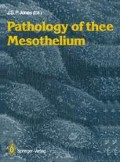Abstract
The terms transudate and exudate look and sound very much alike, and as both of them describe some form of oedema, they are sometimes used (wrongly) as synonyms. Their proper use is, however, of more than semantic interest because transudates and exudates arise by different mechanisms, and are therefore found in different clinical settings. Further, their compositions are different, especially with regard to protein concentrations. It is usually possible in a sample of effusion fluid collected from a serosal cavity of the body to identify it as transudate or exudate, based on its protein content; this identification is usually of great diagnostic importance.
Access this chapter
Tax calculation will be finalised at checkout
Purchases are for personal use only
Preview
Unable to display preview. Download preview PDF.
References
Anderson GL, Miller FN (1984) Inhibition of histamine-induced protein leakage in rat skeletal muscle by blockade of prostaglandin synthesis. Microvasc Res 28: 51–61
Crunkhorn P, Willis AL (1971) Cutaneous reaction to intradermal prostaglandins. Br J Pharmacol 41: 49–56
Dale HH, Laidlaw PP (1919) Histamine shock. J Physiol (Lond) 52: 355 - 390
Dunham BM, Hechtman HB, Valeri CR et al. (1984) Anti-inflammatory agents inhibit microvascular permeability induced by leukotrienes and by stimulated human neutrophils. Microcirc Endothel and Lymphat 1: 465–489
Ford-Hutchinson AW (1985) Leukotrienes: their formation and role as inflammatory mediators. Fed Proc 44: 25–29
Freeman BA, Crapo JD (1982) Biology of disease. Free radicals and tissue injury. Lab Invest 47: 412–426
Fridovich I (1975) Superoxide dismutase. Ann Rev Pharmacol 44: 147–149
Grega GJ, Adamski SW, Svensjo E (1985) Is there evidence for venular large junctional gap formation in inflammation? Microcirc Endothel Lymphat 2: 211–233
Guyton AC (ed) (1981) Textbook of medical physiology. Saunders, Philadelphia London Toronto, pp 358–382
Hsuen W, Arroyave CM, Jordan RL (1984) Identification of C3b as the major serum protein that stimulates prostaglandin and thromboxane synthesis by macrophages. Prostaglandins 28: 889–904
Ignarro LJ (1974) Regulation of lysosomal enzyme secretion: role in inflammation. Agents and Actions 4: 241–258
Jose PJ, Page DA, Wolstenholme TE, Williams TJ, Dumonde DC (1981) Bradykinin-stimulated prostaglandin E2 production by endothelial cells and its modulation by anti-inflammatory compounds. Inflammation 5: 363–378
Jose PJ, Forrest MJ, Williams TJ (1983) Detection of the complement fragment C3a in inflammatory exudates from the rabbit peritoneal cavity using radioimmunoassay. J Exp Med 158: 2177–2182
Laposata M, Dovnarsky DK, Shin HS (1983) Thrombin-induced gap formation in confluent endothelial cell monolayers in vitro. Blood 62: 549–556
Nasjletti A, Malik KU (1979) Relationships between the kallikrein-kinin and prostaglandin system. Life Sei 25: 99–110
Ody C, Seillan S, Russo-Marie S (1982) 6-Ketoprostaglandin Fl alpha, prostaglandin E2, F2 alpha and thromboxane B2 production by endothelial cells, smooth muscle cells and fibroblasts cultured from piglet aorta. Biochem Biophys Acta 712: 103–110
Palade GE, Simionescu M, Simionescu N (1979) Structural aspects of the permeability of the microvascular endothelium. Acta Physiol Scand [Suppl] 463: 11–32
Rocha e Silva M, Beraldo WT, Rosenfeld C (1949) Bradykinin: a hypotensive and smooth muscle stimulating factor released from plasma globulin by snake venom and by trypsin. Am J Physiol 156:261– 266
Rogers KA, Kalnins VI (1983) Comparison of the cytoskeleton in aortic endothelial cells in situ and in vitro. Lab Invest 49: 650–654
Roos D (1980) The metabolic response to phagocytosis. In: Wiessmann G (ed) The cell biology of inflammation. Elsevier-North Holland, Amsterdam New York Oxford (Handbook of inflammation vol 2.) pp 337–387
Rowlands FN, Donovan MJ, Picciano PT, Wilner GD, Kreutzer DL (1984a) Fibrin-mediated vascular injury: identification of fibrin peptides that mediate endothelial cell retraction. Am J Pathol 117:418– 428
Rowlands FN, Donovan MJ, Picciano PT, Kreutzer DL (1984b) Fibrin-medicated vascular injury: identification of vascular cell retraction in response to soluble fibrin-associated factors. J Exp Pathol 1: 217–240
Rubin BT (1977) A theoretical model of the pinocytic vesicular transport process in endothelial cells. J Theor Biol 64: 619–647
Samuelsson B (1983) Leukotrienes: Mediators of immediate hypersensitivity reactions and inflammation. Science 220: 568–575
Schayer RW (1966) Enzymatic formation of histamine from histidine. In: Eichler O, Farah A (eds) Handbook of experimental pharmacology, vol 18. Springer, Berlin pp 688–725
Schwabe AD, Lehman TJA (1984) C5-inhibitor deficiency: A role in familial Mediterranean fever? N Engl J Med 311: 312
Serhan CN, Hamberg M, Samuelsson B (1984) Lipoxins: Novel series of biologically active compounds formed from arachidonic acid in human leukocytes. Proc Natl Acad Sei USA 81: 5335–5339
Simmons K (1984) Defence against free radicals has therapeutic implications JAMA 251: 2187–2191
Weksler BB, Marcus AJ, Jaffe EA (1977) Synthesis of prostaglandin 12 (prostacyclin) by cultured human and bovine endothelial cells Proc Natl Acad Sei USA 74: 3922–3926
Wong PYK, Hughes R, Lam B (1985) Lipoxene: a new group of trihydroxypentaenes of eicosapentaenoic acid from pork leukocytes. Biochem Biophys Res Commun 125: 763–772
Zimmerli W, Lew PD, Cohen HJ et al. (1984) Comparative superoxide-generating system of granulocytes from blood and peritoneal exudates. Infect and Immun 46: 625–630
Editor information
Editors and Affiliations
Rights and permissions
Copyright information
© 1987 Springer-Verlag Berlin Heidelberg
About this chapter
Cite this chapter
Brachet, E.A. (1987). The Mechanism of Effusions in the Serosal Cavities. In: Jones, J.S.P. (eds) Pathology of the Mesothelium. Springer, London. https://doi.org/10.1007/978-1-4471-1404-8_3
Download citation
DOI: https://doi.org/10.1007/978-1-4471-1404-8_3
Publisher Name: Springer, London
Print ISBN: 978-1-4471-1406-2
Online ISBN: 978-1-4471-1404-8
eBook Packages: Springer Book Archive

